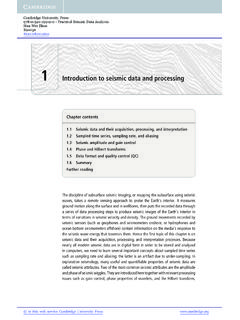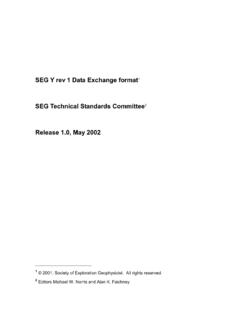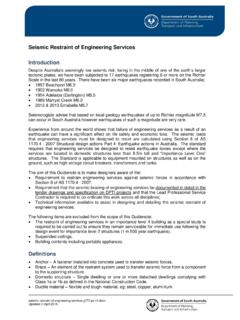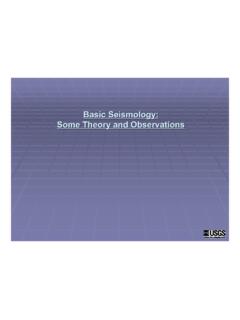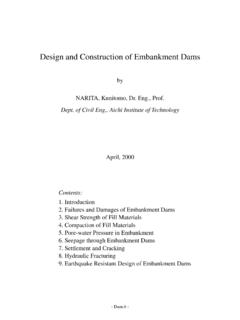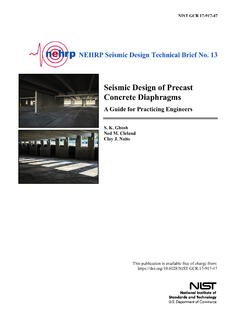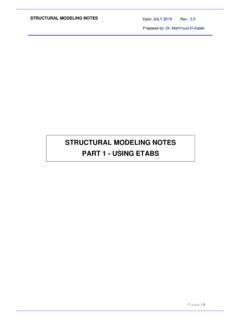Transcription of Seismic Attributes and Their Applications in Seismic ...
1 Bulletin of Earth Sciences of Thailand Koson et al., 2014. Seismic Attributes and Seismic geomorphology. Vol. 6, No. 1, 1-9 Seismic Attributes and Their Applications in Seismic Geomorphology Sanhasuk Koson, Piyaphong Chenrai* and Montri Choowong Department of Geology, Faculty of Science, Chulalongkorn University, Bangkok 10330, Thailand *Corresponding author email: ABSTRACT Seismic Attributes are the components of the Seismic data , which are obtained by measurement, computation, and other methods from the Seismic data . Seismic attribute analysis can extract information from Seismic data that is, otherwise, hidden in the data and have been used to identify prospects, ascertain depositional environments. Hence, many new Attributes were used in Seismic geomorphology study.
2 Most of these Attributes are yet to be understood by many geoscientists and interpreters. The main aim of this paper is to review and introduce the most commonly used Seismic Attributes and Their usage as interpretation tool for Seismic geomorphology. Key words: Seismic Attributes , Seismic geomorphology, Local structural dip 1. Introduction Recent development of three-dimensional (3-D) Seismic datasets enables geologists to visualize and analyze buried-lands and sea-scapes revealed by subsurface geophysical data in a manner resembling surface geomorphology. Seismic geomorphology is useful technique to interpret Seismic patterns for geomorphology of a formation, which is similar to using satellite and aerial photos of the Earth s surface.
3 Seismic geomorphology interpretation is also a primary method in viewing, mapping subsurface geologic features, and making interpretation of structure and stratigraphy possible away from well control in petroleum exploration. Seismic Attributes have been increasingly used in petroleum exploration and production and have been integrated in the Seismic interpretation process. Since 1990s, the Seismic Attributes have been developed into many types of them such as structural Attributes and stratigraphic Attributes (Chopra and Marfurt, 2005). The fundamental Seismic data type is amplitude data , but Seismic Attributes can reveal characteristics, which are not easily seen in amplitude data themselves.
4 The Seismic attribute technique should allow us to increase ability of geological interpretation of a formation, particularly in the thin bed reservoir environments. Seismic Attributes typically provide information relating to the amplitude, shape, and position of Seismic waveform. Seismic attribute analysis can extract information from Seismic data that is otherwise hidden in the data and have been used to identify prospects, ascertain depositional environments ( Academic article 1 Bulletin of Earth Sciences of Thailand Koson et al., 2014. Seismic Attributes and Seismic geomorphology. Vol. 6, No. 1, 1-9 fluvial or deep water channels, carbonate buildups), detect and enhance faults and fracture sets to unravel structural history, and even provide direct hydrocarbon indicators.
5 The purpose of this paper is to review and introduce some Seismic Attributes for Seismic geomorphology. It is aimed to provide geoscientists with the minimum required theory of how each attribute is generated and to understand the Seismic attribute application at basic stage. 2. Envelope attribute Envelope attribute or reflection strength displays acoustically strong (bright) events on both negative and positive events and is the most popular trace attribute. It is calculated from the complex trace of Seismic signal used to highlights main Seismic features. The envelope represents the instantaneous energy of the signal and is proportional in its magnitude to the reflection coefficient.
6 The envelope is useful in highlighting discontinuities, changes in lithology, faults, deposition variation, tuning effect, and sequence boundary. Bright spots from this attribute are important as they can indicate gas, especially in relatively young clastic sediments. The advantage of using this attribute instead of the original Seismic trace values is that it is independent of the phase or polarity of the Seismic data , both of which affect the apparent brightness of a reflection (figure 1). The bright spots probably are corresponded to channel bodies or sand layers due to an acoustic impedance contrast. Faults in the envelope attribute are usually characterized by lateral discontinuous features.
7 However, it is difficult to observe on the Seismic attribute (Koson, 2014). 3. Root Mean Square (RMS) Amplitude RMS amplitude provides a scaled estimate of the trace envelope. It is computed in a sliding tapered window of N samples as the square root of the sum of all the trace values x squared where w and n are the window values as presented in Equation 1. Equation 1. 2 Bulletin of Earth Sciences of Thailand Koson et al., 2014. Seismic Attributes and Seismic geomorphology. Vol. 6, No. 1, 1-9 Figure 1. Examples of original volume (A) and resultant envelope attribute volume (B). The attribute values range from 0 (blue) to (red) as shown on the color bar ( ).
8 RMS amplitude resembles a smoother version of reflection strength. It is applied in the same way as reflection strength to reveal bright spots and amplitude anomalies in the Seismic data (figure 2). In contrast with reflection strength, the resolution can be set by changing the window length, longer windows produce a smoother amplitude estimation, which is sometimes useful. This attribute is useful to highlight coarser-grained facies, compaction related effects ( in marl and limestone) and unconformities. Figure 2. Examples of original volume (A) and resultant RMS amplitude attribute volume (B). The attribute values range from 0 (blue) to 127 (red) as shown in the default color bar ( ).
9 3 Bulletin of Earth Sciences of Thailand Koson et al., 2014. Seismic Attributes and Seismic geomorphology. Vol. 6, No. 1, 1-9 4. Local Structural Dip Structural dip or dip deviation attribute is an edge detection method which designates rapid changes in local dip, such as fractures and channel margins. Structural dip attribute has a good ability for detecting features from dip of reflections such as channel edges and faults (figure 3). The dip deviation attribute does indicate disruptions in reflectors but in the figure 3 only roughly indicates the position of the channels owing to the depositional variability indicated by the shallow reflectors (Pigott et al., 2013). Vertical Seismic profiles can be used to discontinuity features, which are interpreted as faults and channel bodies.
10 Hence, this attribute can be used to outline channel geometry and channel edge in Seismic geomorphology interpretation. In addition, combination of structural dip attribute with other Attributes can enhance interpretation of Seismic geomorphology. Figure 3. Structural dip attribute shows interpreted channels from Seismic cross section. The black arrows highlight the reflector discontinuity (Pigott et al., 2013). 5. Sweetness Sweetness (instantaneous amplitude divided by the square-root of instantaneous frequency) is defined as the trace envelope a(t) divided by the square root of the average frequency fa(t) as presented in Equation 2. Equation 2.
